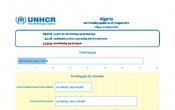Algeria
Operation: Algeria
Location
{"longitude":3,"latitude":27,"zoom_level":5}
Latest update of camps and office locations 21 Nov 2016. By clicking on the icons on the map, additional information is displayed.
Key Figures
| 2016 year-end results | |
| 100% | of refugee children in Algiers were supported to afford annual school enrolment fees, transport and school lunch |
| 90,000 | vulnerable Sahrawi refugees were provided with 18 litres of water per person per day |
| 32,100 | children in camps near Tindouf were enrolled in primary education |
| 43 | refugee cases were submitted to resettlement; 16 departed for their resettlement country |
| 37 | youth, community or business projects (reaching 122 young refugees in total) were supported |
| 2017 planning figures | |
| 100% | of refugees and asylum seekers in urban areas will to be provided with individual protection documentation |
| 100% | of school-aged refugee children are enrolled in secondary education |
| <20% | Prevalence of chronic malnutrition amongst Western Sahara refugee children (6-59 months) is reduced to below 20% |
| 500 | refugees from Western Sahara will be provided with entrepreneurship / business training |
| 20 | litres of potable water will be available daily for each refugee from Western Sahara living in a camp |
Latest Updates
People of Concern
1%
Decrease in
2016
2016
| 2016 | 99,949 |
| 2015 | 100,775 |
| 2014 | 99,005 |

[["Refugees",94232],["Asylum-seekers",5712],["Returned refugees",5]]
Loading ...
Algeria
< Back
2016
{"categories":[2012,2013,2014,2015,2016,2017],"budget":[25.55462477,28.17015775,32.70824967,33.227035854,28.96476598,36.53872598],"expenditure":[13.62484434,15.08854711,14.41533372,16.01047015,16.14724515,null]}
{"categories":[2012,2013,2014,2015,2016,2017],"p1":[25.55462477,28.17015775,32.70824967,33.227035854,28.96476598,36.53872598],"p2":[null,null,null,null,null,null],"p3":[null,null,null,null,null,null],"p4":[null,null,null,null,null,null]}
{"categories":[2012,2013,2014,2015,2016,2017],"p1":[13.62484434,15.08854711,14.41533372,16.01047015,16.14724515,null],"p2":[null,null,null,null,null,null],"p3":[null,null,null,null,null,null],"p4":[null,null,null,null,null,null]}
Loading ...
CHOOSE A YEAR
- 2014
- 2015
- 2016
- 2017
Working environment
UNHCR continued to support the authorities to enhance the protection space in Algiers, taking into account the mixed movements, and the protection and assistance of urban refugees. In December 2016, a small number of refugees were affected by an operation targeted at sub-Saharan migrants deported from Algiers to Tamanrasset as well as to Niger; UNHCR liaised with authorities to facilitate their return.UNHCR and partners provided protection and humanitarian assistance to 90,000 vulnerable Sahrawi refugees in camps near Tindouf. Funding shortfalls affected the delivery of life-saving assistance, including food assistance.
Population trends
Some 5,940 people of concern of which 5,330 were from the Syrian Arab Republic and 227 recognized as refugees based on mandate refugee status determination (RSD). UNHCR does not carry out individual RSD for Syrians in Algeria. The main countries of origin of recognized refugees were Cameroon, the Central African Republic, Côte d’Ivoire and the Democratic Republic of the Congo.Achievements and impact
- In Algiers, UNHCR continued to provide basic assistance (including shelter, health, food and cash assistance) and protection (including registration, refugee status determination, and legal support) to urban refugees and asylum-seekers.
- In Tindouf, UNHCR continued to support the Saharawi health care system, providing life-saving equipment, supplies and medicines, as well as support for health workers. UNHCR also supported a safe house to accommodate a total of 8 unwed pregnant women and mothers.
- UNHCR provided shelter support to 5,901 refugees in Tindouf.
- UNHCR provided fuel for cooking and for heating up water for personal hygiene to 28,000 families each month for eight months.
Unmet needs
- Infrastructure to provide water to the camps near Tindouf needs to be maintained and extended to Layyoune, Awserd and Dakhla. Despite improvement in the water system, the amount of water provided per person per day remains below the UNHCR’s standard of 20 litres, at 18 litres.
- More than 70 per cent of the families in need of shelter assistance were not assisted due to limited funding.
- Food assistance to Sahrawi refugees in camps near Tindouf were reduced as a result of underfunding. Due to the decrease in food rations, food security could not be achieved in the camps.
The main groups of concern to UNHCR in Algeria are: some 90,000 Sahrawi refugees who have been residing in five camps near Tindouf for over 40 years; the urban caseload of mostly sub-Saharan refugees and asylum-seekers in Algiers; and refugees and asylum-seekers who fled the crises in Mali and the Syrian Arab Republic. The Government estimates there are some 43,000 Syrian refugees in Algeria and UNHCR had registered 5,600 as asylum-seekers by August 2015.
The Office carries out registration, status determination, assistance, and resettlement activities in Algiers. The Government provides free medical services and education to people of concern. UNHCR’s protection strategy in Algeria includes ongoing advocacy for the establishment of a sound legislative framework, while ensuring current protection standards. In the camps near Tindouf, the vulnerability of the Sahrawi refugees continues to increase. The Algerian Government continues to support the Saharawi refugees with water, electricity and roads, but the population remains dependent on international humanitarian assistance. Alongside the continued assistance to ensure minimum levels of essential services, UNHCR will implement a livelihoods strategy for this population of concern in 2016, subject to funds being available.





